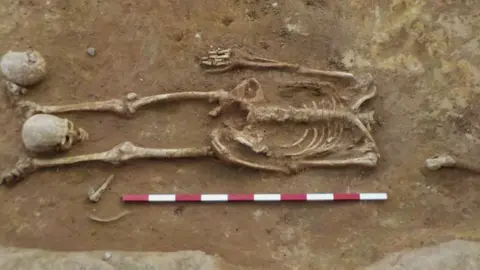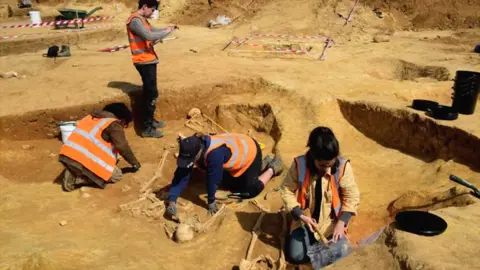Decapitated bodies found in Roman cemetery in Great Whelnetham
 Archaeological Solutions
Archaeological SolutionsArchaeologists excavating a Roman burial ground said the discovery of a series of decapitated bodies was a "rare find".
A dig has been taking place on a site in Great Whelnetham, Suffolk, ahead of a planned housing development.
Of the 52 skeletons found, about 40% had their skulls detached from their bodies, many placed by their legs.
Archaeologist Andrew Peachey said it gave a "fascinating insight" into Roman burial practice.
 Archaeological Solutions
Archaeological SolutionsThe Roman cemetery, which dates to the 4th Century, includes the remains of men, women and children who had probably lived in a nearby settlement.
The fact that up to 40% of the bodies were decapitated represents "quite a rare find", particularly having the "statistical anomaly of having so many decapitations there".
"We are looking at a very specific part of the population that followed a very specific tradition of burial," he said.

Roman Suffolk
 British Museum
British Museum- The county of Suffolk was under the control of the Iceni tribe when the Romans invaded in the 1st Century
- From the mid 1st Century to the early 5th centuries AD it was an intensely populated area between the major Roman settlements of Colchester and Caistor, near Norwich
- A hoard of 4th Century Roman silver, including the Great Dish, was found in Mildenhall in 1942
- One of the most significant Roman sites in Suffolk is the villa complex at Castle Hill in Ipswich, comprising several buildings, perhaps arranged around a courtyard
- The Roman settlement Great Whelnetham may date back to the 1st Century

Mr Peachey, of Archaeological Solutions, said he did not believe there had been executions.
The heads were likely to have been removed "carefully" after the individual had died, he added.
The team are analysing the bones to find out as much as possible about the population.
 Archaeological Solutions
Archaeological SolutionsGreat Whelnetham is a known Roman settlement and Roman burials were typically placed as we would place them, said Mr Peachey.
The skeletons will go to a museum archive.
